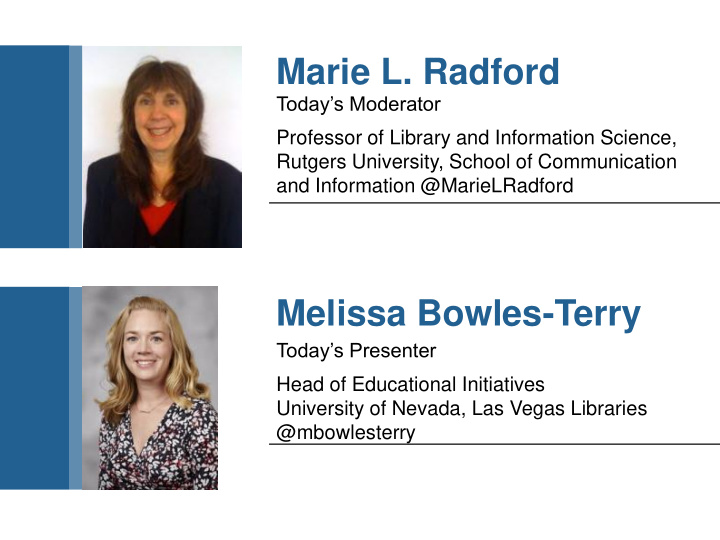



Marie L. Radford Today’s Moderator Professor of Library and Information Science, Rutgers University, School of Communication and Information @MarieLRadford Melissa Bowles-Terry Today’s Presenter Head of Educational Initiatives University of Nevada, Las Vegas Libraries @mbowlesterry
Take Action: Using and Presenting Research Findings to Make Your Case Melissa Bowles-Terry Head of Educational Initiatives University of Nevada, Las Vegas Libraries
What story does your assessment data tell? Image Credit: Photograph by Unsplash
Which library services or resources are likely to be impacted by the information you’ve gathered? Instruction or program Reference Educational role Space, physical Discovery: institutional web, resource guides Collections Personnel Scholarly communications Other (post to chat)
Translate Findings to Action Image Credit: Photographs by Unsplash
Who are the stakeholders? Image Credit: Photograph by Unsplash
Stakeholder identification -- academic library Internal Students Faculty Library Administration External Parents Accreditors Local Funders community From Academic Library Value: The Impact Starter Kit, Megan Oakleaf, 2017
Stakeholder identification -- public library Local Government Library Staff & Board Local Non-profits ● ● ● Board of commissioners Board of trustees Homeless associations ● ● ● Public works Library administration American Red Cross ● ● ● Economic development Full-time/part-time staff United Way ● ● ● Planning & zoning Volunteers Local church groups ● Friends of the library Public Schools Community & commuting Employers ● ● Staff & faculty users Federal, state, local ● ● Students & parents Local residents employers ● ● ● Homeschool community Commuters Private businesses ● ● Nearby communities Military bases ● Small businesses
Developing key messages for stakeholder groups Image Credit: Photograph by Unsplash
What stakeholder group are you speaking to? What are their priorities? ● What is their preferred communication method? ● What is your key message? ● ○ 3 points (maximum) ○ 9 seconds ○ 27 words See more about 27-9-3 Rule: http://www.powerprism.org/27-9-3-elevator-pitch.htm
Example: Improving outreach at a public library Library Staff : Improving outreach ● Public Relations : Creating a social media ● campaign Patrons : Providing bookmobile services, address ● accessibility Director/Assistant Director : ● Marketing and communication increase outreach Image Credit: Photograph by Unsplash
Example: Eliminating fines at a public library Programmers: Remain true to our strategic plan ● and bring non-users, not afraid of fines Circulation staff: Patrons still held responsible ● lost/damaged items, expected to return materials in a timely manner Library users: Okay to check out 50 books, you ● won’t incur fines! Former library users: Welcome ● back! We value you and want you to experience the full range of services that your library has to offer
Example: Embedding library resources in online courses at a university Students: Library embedded within all course ● pages Faculty: Collaborative relationship with library ● staff improves curriculum Library staff: Universal ● access will increase library traffic, both digital and physical and increase awareness of library services, importance to all stakeholders Image Credit: Photograph by Unsplash
Example: Adding outreach events at an academic library to reach diverse student groups Library staff: Outreach programming will deliver ● service to more patrons Student groups: Library understands the impact ● groups have on the students, eager to aid your members First-year students: Library assists in transition from ● high school to college Office of the Vice Provost for ● Educational Equity: Library committed to helping University meet strategic goals Image Credit: Photograph by Unsplash
What stakeholder group are you speaking to? What are their priorities? ● What is their preferred communication method? ● What is your key message? ● ○ 3 points (maximum) ○ 9 seconds ○ 27 words See more about 27-9-3 Rule: http://www.powerprism.org/27-9-3-elevator-pitch.htm
Where are the Gaps? Image Credit: Photograph by Unsplash
Questions? Follow-ups? melissa.bowles-terry@unlv.edu @mbowlesterry Image Credits: Photographs by Unsplash
Thank you! Questions and Discussion #libdata4impact Marie L. Radford Melissa Bowles-Terry Professor of Library and Information Head of Educational Initiatives Science, Rutgers University, School of University of Nevada, Las Vegas Libraries Communication and Information @mbowlesterry @MarieLRadford melissa.bowles-terry@unlv.edu mradford@comminfo.rutgers.edu
Webinar Series: Evaluating and Sharing Your Library’s Impact Part 1: Part 3: Part 2: April 24 October 3 August 14 Linda Kara Reuter Melissa Hofschire Bowles-Terry User-centered Assessment: Digging into Take Action: Using Leveraging What Assessment Data: and Presenting You Know and Tips, Tricks, and Research Findings Filling in the Gaps Tools of the Trade to Make Your Case For more information: https://www.webjunction.org/news/ webjunction/webinar-series-research-assessment.html #libdata4impact
Series Learner Guide Use alone or with others to apply what you’re learning between sessions. 13 pages of questions, activities, and resources. Customizable to meet your team’s needs!
Recommend
More recommend